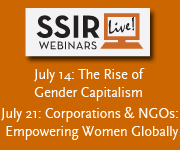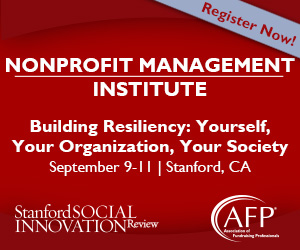Going Lean
Supplements to the article “The Promise of Lean Experimentation.”
Magazine Extras (Spring 2015)
Supplement to the article “The Promise of Lean Experimentation.”
In the business sector, rapid experimentation techniques have become a widely used means of facilitating innovation. Yet so far nonprofit organizations and their funders have been relatively slow to adopt those methods. In “The Promise of Lean Experimentation,” a feature article in the summer 2015 issue of SSIR, Peter Murray and Steve Ma discuss some of the reasons why that is so. More to the point, they describe the value that rapid experimentation approaches—including, in particular, the practice of “lean” experimentation—can offer to people in the social sector.
To supplement the article, Murray and Ma have prepared two items that deliver actionable insight on how social sector practitioners can enable lean experimentation. We share this material with gratitude to the authors.
In their SSIR article, Murray and Ma had limited scope to explore the ins and outs of turning lean concepts into lean practice. So here they offer a descriptive list of online resources that will help readers take the next step on their rapid experimentation journey.
LEAN RESOURCES
By Peter Murray & Steve Ma
From listening to constituents out in the field to developing testable programs and services, lean experimentation in the social sector is a fundamentally hands-on endeavor. Fortunately, tools are available for practitioners to use at each stage of the lean process.
Understanding the Lean Mindset | Any social change practitioner who has an interest in lean experimentation should start by reading The Lean Startup: How Today’s Entrepreneurs Use Continuous Innovation to Create Radically Successful Businesses, by Eric Ries. In the book, Ries explains the core ideas behind lean experimentation and provides several case studies as well. Although business readers are the target audience for Lean Startup, Ries sets forth a general framework that will be helpful to those who want to pursue lean for social impact.
Building in a Lean Way | Practitioners who are ready to start implementing lean should turn next to the book Value Proposition Design: How to Create Products and Services Customers Want, by Alexander Osterwalder and Yves Pigneur. It’s a highly accessible work that offers easy-to-understand lessons for people who want to build products and services that will meet the needs of their customers. We also strongly recommend the companion set of online tools that is available to anyone who buys the book. Among those tools, you’ll find templates that will help you think through what your constituents actually need and whether your solution will fill that need. You’ll also gain access to tools that will help you prioritize and test your critical hypotheses. All of these tools are robust, but let us offer a word of warning: Don’t let them overwhelm you. Instead, focus on the basics. Listen to your constituents, come up with some ideas, and start building and testing your ideas as soon as possible.
Prototyping Lean Solutions | A critical principle of lean is to build fast and learn. Before you construct a full-scale product, in other words, create a prototype and test it on your target market. To see what this principle looks like in practice, watch a video called “Build a Tower, Build a Team.” In the video, Tom Wujec (a fellow at Autodesk and an adjunct professor at Singularity University) describes a team-building exercise in which participants build a tower using a few simple—albeit somewhat unusual—ingredients: spaghetti, tape, string, and a marshmallow. It’s an exercise that illustrates the power of prototyping in a very compelling way.
Enabling Funders | A nonprofit can go only so far with lean experimentation if its funders are neither inclined nor equipped to support that effort. A growing number of foundations have made a significant shift toward sponsoring rapid experimentation, but many others have yet to take that step. Our team at Accelerate Change has put together a toolkit called “Funding Radical Experimentation.” It outlines key strategies for funding methods such as lean and includes examples of foundations that are already pursuing those strategies.
“For rapid experimentation to become widespread in the social sector, funders will need to embrace new approaches to supporting innovation,” Murray and Ma write in the article. “Traditional funding processes for nonprofits discourage rapid experimentation by reinforcing risk aversion and an adherence to top-down planning.” To help funders break away from that “traditional” pattern, the authors have developed the toolkit cited previously. In addition, they have distilled some of their thoughts on that topic into a brief sidebar.
FUNDING LEAN APPROACHES
By Peter Murray & Steve Ma
Funders can encourage the use of lean throughout their portfolio. Program officers, for instance, can support the lean model by making modest adjustments to their grantmaking process. Here are concrete steps that funders can take in this regard.
- Ask your grantees which programs or services they would be eager to test if they had enough time and resources to do so.
- Create specific experimentation grants. Support of this kind can range from six-month “prototype” grants ($30,000 to $50,000) to multi-year funding for a lean experimentation team ($200,000 to $500,000 per year).
- Allow for unexpected pivots. Don’t require grantees to spell out—in advance and in detail—the specific tactics and strategies that they will employ.
- Actively support efforts by grantees to make rapid, data-driven shifts in their program design.
- Empower grantees to follow a nonlinear process—one that that doesn’t adhere to a traditional timeline. They might run a new experiment every two to four months, for example. Or they might drop an idea after two weeks of constituent discovery. Or they might test an idea that they hadn’t considered during the grant application phase.
- Measure success not by intermediate program outputs (the number of people served, for example) but by the amount of learning that grantees achieve through the rapid validation or invalidation of critical hypotheses.
- Encourage grantees, as part of their experimentation, to test approaches that promote financial sustainability.


 By adopting a model from business, nonprofit organizations can launch, test, and implement new programs and services more efficiently.
By adopting a model from business, nonprofit organizations can launch, test, and implement new programs and services more efficiently.  If we want the nonprofit sector to innovate, we need to acknowledge the gender gap between nonprofits and the private sector.
If we want the nonprofit sector to innovate, we need to acknowledge the gender gap between nonprofits and the private sector.
 Three principles for solving complex, systemic problems like improving community health.
Three principles for solving complex, systemic problems like improving community health.
 As the momentum of impact investing builds, the lack of proper taxonomy poses a significant risk to the movement, especially given recent growth.
As the momentum of impact investing builds, the lack of proper taxonomy poses a significant risk to the movement, especially given recent growth.
 Why a recent exposé on Red Cross failures in Haiti highlights unrealistic expectations for social sector organizations.
Why a recent exposé on Red Cross failures in Haiti highlights unrealistic expectations for social sector organizations.
 Marketing professor Jennifer Aaker shows how stereotypes can be reframed to influence consumer behavior for nonprofits.
Marketing professor Jennifer Aaker shows how stereotypes can be reframed to influence consumer behavior for nonprofits.
 How to maintain membership lists without a lot of operations money: Whitcanack on BigTent.
How to maintain membership lists without a lot of operations money: Whitcanack on BigTent.
 Challenges nonprofit professionals face in an increasingly fast-paced, demanding world.
Challenges nonprofit professionals face in an increasingly fast-paced, demanding world.
 Why are so many nonprofits in a perpetual starvation cycle? How capacity building and systems are crucial nonprofit building points.
Why are so many nonprofits in a perpetual starvation cycle? How capacity building and systems are crucial nonprofit building points.
 Four practices that can help people establish common intent; sense emerging needs and solutions; and collectively prototype, create, and evolve innovative health models and relationships.
Four practices that can help people establish common intent; sense emerging needs and solutions; and collectively prototype, create, and evolve innovative health models and relationships.



